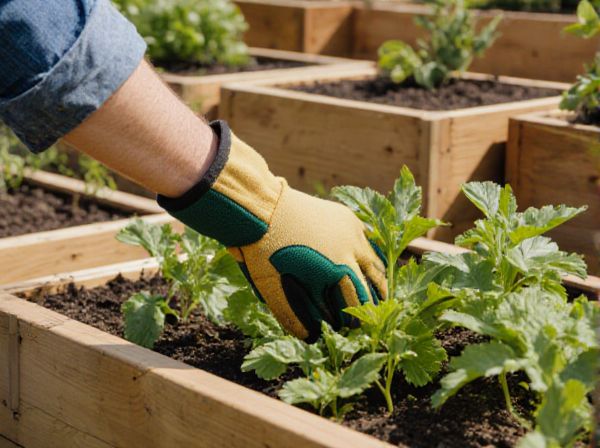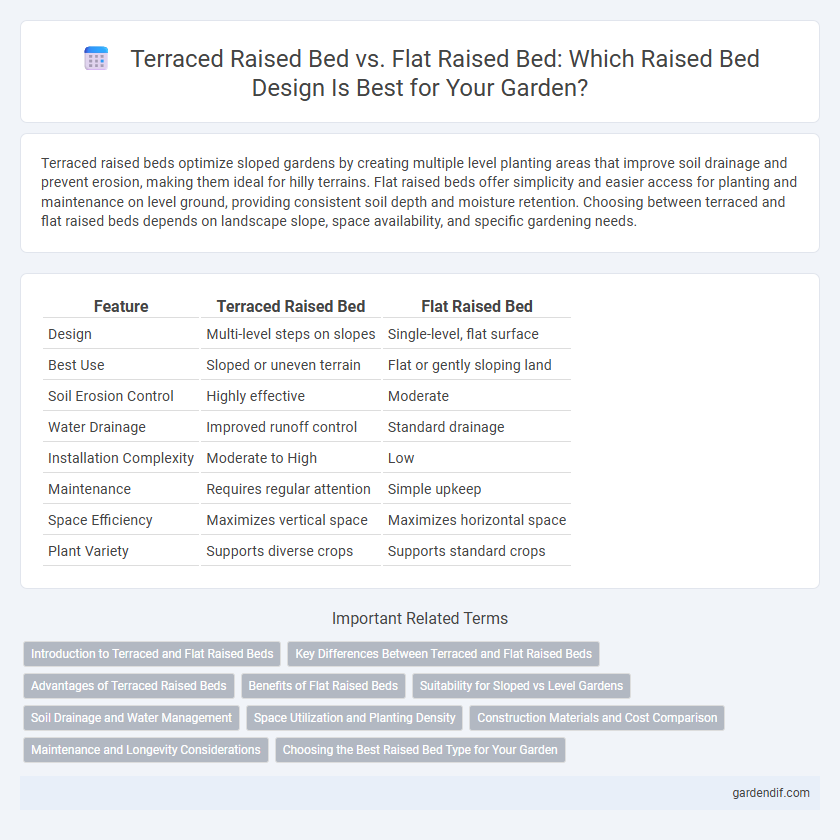
Terraced raised bed vs Flat raised bed Illustration
Terraced raised beds optimize sloped gardens by creating multiple level planting areas that improve soil drainage and prevent erosion, making them ideal for hilly terrains. Flat raised beds offer simplicity and easier access for planting and maintenance on level ground, providing consistent soil depth and moisture retention. Choosing between terraced and flat raised beds depends on landscape slope, space availability, and specific gardening needs.
Table of Comparison
| Feature | Terraced Raised Bed | Flat Raised Bed |
|---|---|---|
| Design | Multi-level steps on slopes | Single-level, flat surface |
| Best Use | Sloped or uneven terrain | Flat or gently sloping land |
| Soil Erosion Control | Highly effective | Moderate |
| Water Drainage | Improved runoff control | Standard drainage |
| Installation Complexity | Moderate to High | Low |
| Maintenance | Requires regular attention | Simple upkeep |
| Space Efficiency | Maximizes vertical space | Maximizes horizontal space |
| Plant Variety | Supports diverse crops | Supports standard crops |
Introduction to Terraced and Flat Raised Beds
Terraced raised beds are structured with multiple stepped levels, ideal for sloped terrain, enhancing water drainage and soil erosion control. Flat raised beds are uniform, level planting areas that simplify planting and maintenance while maximizing space efficiency in flat landscapes. Both designs improve soil quality, root growth, and accessibility compared to traditional in-ground gardening.
Key Differences Between Terraced and Flat Raised Beds
Terraced raised beds feature multiple levels built on a slope, optimizing space and improving drainage, while flat raised beds are constructed on level ground, offering easier access and uniform soil depth. Terraced beds help prevent soil erosion and are ideal for sloped gardens, whereas flat beds provide simpler installation and are better suited for flat landscapes. The choice depends on terrain, drainage needs, and gardening goals, with terraces supporting complex designs and flats favored for straightforward cultivation.
Advantages of Terraced Raised Beds
Terraced raised beds optimize gardening on sloped terrain by preventing soil erosion and enhancing water retention, which promotes healthier plant growth. They allow for efficient use of vertical space, enabling the cultivation of diverse crops within a compact area. This design improves accessibility and maintenance, reducing physical strain during planting and harvesting.
Benefits of Flat Raised Beds
Flat raised beds offer superior water retention and even soil distribution, promoting healthier root development and improved crop yields. They enable easier access for planting and maintenance, reducing soil compaction and enhancing aeration. These beds also simplify irrigation management, making them ideal for small gardens and urban settings.
Suitability for Sloped vs Level Gardens
Terraced raised beds are ideal for sloped gardens as they prevent soil erosion by creating multiple flat planting surfaces on different levels, enhancing water retention and root stability. Flat raised beds suit level gardens where uniform soil depth and easy access facilitate planting and maintenance. Choosing terraced beds on slopes optimizes space and reduces runoff, while flat beds maximize usability and irrigation efficiency on flat terrain.
Soil Drainage and Water Management
Terraced raised beds offer superior soil drainage by utilizing stepped levels that prevent waterlogging and promote runoff control, making them ideal for sloped terrains. In contrast, flat raised beds require careful soil amendment and drainage solutions to avoid standing water, especially in heavy clay soils. Efficient water management in terraced beds reduces erosion risks, while flat beds rely on consistent irrigation practices for optimal moisture retention.
Space Utilization and Planting Density
Terraced raised beds maximize space utilization on sloped terrain by creating multiple levels, allowing for higher planting density through increased vertical growing area. Flat raised beds offer a simpler layout ideal for even ground but may limit planting density due to horizontal space constraints. Terracing also improves drainage and reduces soil erosion, enhancing overall plant health and productivity compared to flat beds.
Construction Materials and Cost Comparison
Terraced raised beds typically require more durable construction materials such as treated lumber, stone, or concrete blocks to support the vertical structure, leading to higher initial costs compared to flat raised beds that often use simpler materials like untreated wood or composite panels. The complexity of terracing demands additional labor and reinforcement, increasing both material and installation expenses. Flat raised beds are generally more cost-effective and easier to build, making them suitable for budget-conscious gardeners prioritizing straightforward construction.
Maintenance and Longevity Considerations
Terraced raised beds require more regular maintenance to manage soil erosion and water drainage effectively, especially on sloped terrain, while flat raised beds experience less erosion but may need enhanced drainage solutions. Materials used for terraced beds, often retaining walls or stonework, tend to have higher durability but require occasional inspection and repair to prevent structural failure. Flat beds constructed from rot-resistant wood or composite materials generally offer longer lifespan with minimal upkeep, making them a low-maintenance choice for gardeners prioritizing longevity.
Choosing the Best Raised Bed Type for Your Garden
Terraced raised beds offer superior soil erosion control and efficient water drainage, making them ideal for sloped gardens, while flat raised beds provide easier access and uniform planting areas suited for level terrain. Selecting the best raised bed depends on your garden's topography, accessibility needs, and crop requirements to maximize growth and maintenance efficiency. Consider materials like cedar or composite lumber for durability and soil amendments to optimize nutrient retention in either bed type.
Terraced raised bed vs Flat raised bed Infographic

 gardendif.com
gardendif.com